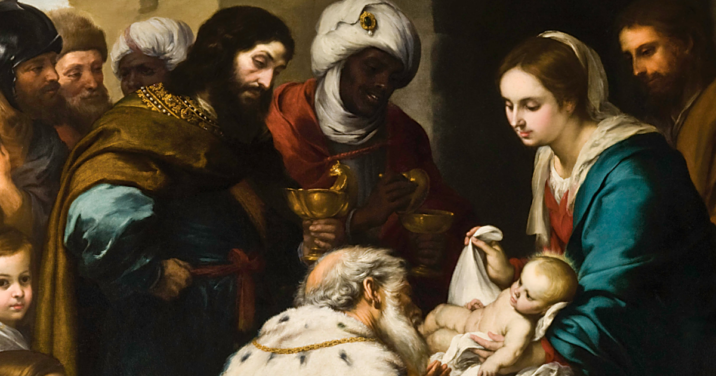What do we really know about the “magi,” the three “wise men” who brought gifts to Jesus?
I get questions like this from my kids all the time, questions about Bible and theology stuff. I love their curiosity. And I often find myself answering them this way: “Well, how could we know?”
They’ve now learned to answer this epistemological question—a question about how we know what we know—with the standard Sunday school reply, “The Bible.” It seems obvious once stated, but the only way Christians can know truths from biblical history with certainty is if the Bible contains them. Or rather, the only historical sources I am morally obligated to believe, and believe completely, are biblical ones.
Here’s what we can know about the wise men, and just about all of it comes from Matthew 2:1–18.
1. They were “magicians.”
First, they were “magi.” The standard Greek-English lexicon, BDAG, defines the magoi as “Wise man and priest, who was expert in astrology, interpretation of dreams and various other occult arts.”
Now, technically, we don’t know what magoi means just from Matthew 2. We have to see how the word was used outside Matthew and outside Scripture. The word shows up in Acts 13 to name a Jewish false prophet, Elymas; the major English translations often call him a “sorcerer.” Outside Scripture the word has a somewhat unclear reference. Carson says “the term loosely covered a wide variety of men interested in dreams, astrology, magic, books thought to contain mysterious references to the future, and the like. Some Magi honestly inquired after truth; many were rogues and charlatans.” (REBC 9:110).
But it feels odd calling the good guys “sorcerers” or implying that they were charlatans, so all the major translations go for either “wise men” or (the transliterated neologistic justified cop-out) “magi.”
2. There were at least two of them.
It is generally assumed that there were three wise men, but that is an inference from the number of gifts they gave. It is nowhere stated in the text of Matthew.
But we do know that the word “wise men”—or, depending on the translation, “magicians” or “magi” or even “astrologers” (REB)—throughout the passage is plural. There were at least two of them. (And there is no indication in the text of the Bible that they are “kings.”)
3. They came from “the East.”
By now you may be realizing that Matthew simply doesn’t say much about these wise men. Many interpreters try to fill in the biblical picture by using a clue in the text:they came from “the East.” They look at some other “wise men” from that direction in Scripture, the “wise men” from the story of Daniel (see chapters 2, 4, and 5).
Since Daniel’s story occurs in Babylon, and Babylon is in “the East,” this has led some writers to conclude the magi came from Babylon, too. However, we simply do not know. We cannot know, because the Bible doesn’t tell us.
4. They rejoiced to see Jesus and worshiped him.
The magi were the first Gentiles to worship Jesus, the first in a long line that now includes me—and most modern Christians.
These Gentiles knew somehow—and once again the Bible doesn’t tell us how—that Jesus was “the king of the Jews.” This was not a fearful but a joyful prospect to them. They were overjoyed to find Jesus, and they fell down to worship him upon finally encountering the child. All the “good” characters in the birth narratives view it that way, an indication that Christ was coming in salvation and not (yet) in judgment.
5. They gave Jesus at least three gifts.
The wise men brought a number of gifts for Jesus: gold, frankincense (a type of incense used in worship) and myrrh (a perfume used in embalming bodies). Christians over the centuries have very naturally speculated about the significance of these: gold for a king, frankincense for a god, myrrh for Christ’s coming burial?
Such speculation is almost irresistible, and it probably does belong in Christian teaching of the story—as long as it is clearly marked as speculation and not allowed to become a new tradition. The passage doesn’t say what significance the magi placed on the gifts, or suggest that they knew enough about “the one born king of the Jews” that they could give such intelligent gifts. The text simply says that they were expensive gifts, “treasures.”
6. Jesus was probably still an infant when they came, and possibly a newborn.
Though we do know that the magi came “after Jesus was born,” we don’t know quite when. It’s common for evangelical interpreters to debunk the standard manger scene view, to point out that the magi and shepherds did not worship Jesus at the same time.
But we may be able to rescue a portion of that debunked scene. The passage says the magi came after the birth of Jesus, and it says they came to the “house” in Bethlehem where Jesus was. Joseph and Mary had apparently moved on from wherever the manger-that-was-not-in-an-inn (we don’t even know if it was inside or outside). But Jesus was not yet in his eventual home town of Nazareth; this suggests that he was either a newborn or a six-week-old child when the magi met him.
That’s because there are only two events in the Gospels that tie the baby Jesus to the area around Bethlehem (which is a two-hour walk from Jerusalem): his birth and his dedication at the temple after Mary’s 40-day purification (see Luke 2:22–38).
We have incomplete data, and various harmonizations of the Matthean and Lukan birth narratives are possible. I offer a few speculations—in order to distinguish them from what we can know:
- It’s possible that the treasures provided by the wise men financed the holy family’s subsequent escape to Egypt. It’s doubtful that people who could only afford to offer pigeons at the 40-day purification (Luke 2:24; Lev 12:1–8) could afford such a journey otherwise.
- But the offering of pigeons suggests that they hadn’t yet been given a bunch of gold. So, we might guess, the magi came after the fortieth day (the day Joseph and Mary “came [to Jerusalem] for their purification according to the Law of Moses,” Luke 2:22). Perhaps the holy family made the short trip from Bethlehem to the temple, then back to their temporary “home base” in Bethlehem, then they met the magi, then they went on to Egypt? Or would they have gone back to Nazareth during the weeks leading up to baby Jesus’ presentation at the temple?
- Luke 2:39 makes it a little difficult to know when the flight to Egypt occurred: “When they had performed everything according to the Law of the Lord, they returned into Galilee, to their own town of Nazareth.” Again, various guesses are possible.
As fun as speculation is, we must admit there’s not very much we can know with certainty about the timing of the magi’s visit.
7. They did not return to Herod.
Whatever exotic Eastern locale the magi came from, their return trip did not require them to go through Jerusalem—or at least near Herod. God warned them in a dream not to do so. This innocent action on their part so infuriated Herod that he killed all the little boys under two in Bethlehem and the whole region.
(The fact that Herod subsequently killed all boys two years old and younger may indicate that Jesus was a toddler when the magi met him, but it may also reflect a delay in Herod’s realization that he’d been tricked and the magi weren’t coming back to see him—or maybe just personal pique, covering all his bases by killing all the boys born since the time the star appeared.)
8. They may have followed a lost prophecy of Daniel.
There is one speculation about the wise men, based on the Bible, which many serious interpreters of Scripture view as plausible: these “magi” may have known to follow their star because the “East” from which they came was Babylon, and the prophet Daniel had left them some messianic prophecy of which we have no record. Daniel was God’s tool to make other prophecies of Christ; perhaps he is the reason for this remarkable portion of the Jesus story.
It’s important to distinguish what we can know from what we can only speculate about—to keep Scripture and tradition healthily distinct. Christmas carols tend to blend truth with tradition, and next thing you know the baby Jesus doesn’t cry (“no crying he makes”), “three ships came sailing in” to Bethlehem (which doesn’t sit on any body of water), and the magoi were “three kings.”
Traditions are fun, but genuine knowledge is justified true belief. Tradition is not an adequate justification for knowledge about 2,000-year-old events, and there is the ever present possibility that traditions will grow to obscure or even contradict the truth.
It is entirely possible, of course, that historical sources outside the Bible might mention Jesus, or Paul, or King David—or the wise men. But everything we are justified in knowing about the Three Kings of Orient comes from the first eighteen verses of the second chapter of Matthew.
***






